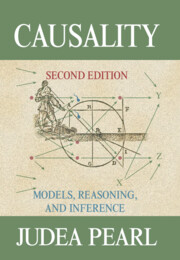Book contents
- Frontmatter
- Dedication
- Contents
- Preface to the First Edition
- Preface to the Second Edition
- 1 Introduction to Probabilities, Graphs, and Causal Models
- 2 A Theory of Inferred Causation
- 3 Causal Diagrams and the Identification of Causal Effects
- 4 Actions, Plans, and Direct Effects
- 5 Causality and Structural Models in Social Science and Economics
- 6 Simpson’s Paradox, Confounding, and Collapsibility
- 7 The Logic of Structure-Based Counterfactuals
- 8 Imperfect Experiments: Bounding Effects and Counterfactuals
- 9 Probability of Causation: Interpretation and Identification
- 10 The Actual Cause
- 11 Reflections, Elaborations, and Discussions with Readers
- Epilogue The Art and Science of Cause and Effect
- Bibliography
- Name Index
- Subject Index
1 - Introduction to Probabilities, Graphs, and Causal Models
Published online by Cambridge University Press: 05 March 2013
- Frontmatter
- Dedication
- Contents
- Preface to the First Edition
- Preface to the Second Edition
- 1 Introduction to Probabilities, Graphs, and Causal Models
- 2 A Theory of Inferred Causation
- 3 Causal Diagrams and the Identification of Causal Effects
- 4 Actions, Plans, and Direct Effects
- 5 Causality and Structural Models in Social Science and Economics
- 6 Simpson’s Paradox, Confounding, and Collapsibility
- 7 The Logic of Structure-Based Counterfactuals
- 8 Imperfect Experiments: Bounding Effects and Counterfactuals
- 9 Probability of Causation: Interpretation and Identification
- 10 The Actual Cause
- 11 Reflections, Elaborations, and Discussions with Readers
- Epilogue The Art and Science of Cause and Effect
- Bibliography
- Name Index
- Subject Index
Summary
Chance gives rise to thoughts, and chance removes them.
Pascal (1670)INTRODUCTION TO PROBABILITY THEORY
Why Probabilities?
Causality connotes lawlike necessity, whereas probabilities connote exceptionality, doubt, and lack of regularity. Still, there are two compelling reasons for starting with, and in fact stressing, probabilistic analysis of causality; one is fairly straightforward, the other more subtle.
The simple reason rests on the observation that causal utterances are often used in situations that are plagued with uncertainty. We say, for example, “reckless driving causes accidents” or “you will fail the course because of your laziness” (Suppes 1970), knowing quite well that the antecedents merely tend to make the consequences more likely, not absolutely certain. Any theory of causality that aims at accommodating such utterances must therefore be cast in a language that distinguishes various shades of likelihood – namely, the language of probabilities. Connected with this observation, we note that probability theory is currently the official mathematical language of most disciplines that use causal modeling, including economics, epidemiology, sociology, and psychology. In these disciplines, investigators are concerned not merely with the presence or absence of causal connections but also with the relative strengths of those connections and with ways of inferring those connections from noisy observations. Probability theory, aided by methods of statistical analysis, provides both the principles and the means of coping with – and drawing inferences from – such observations.
The more subtle reason concerns the fact that even the most assertive causal expressions in natural language are subject to exceptions, and those exceptions may cause major difficulties if processed by standard rules of deterministic logic. Consider, for example, the two plausible premises:
1. My neighbor's roof gets wet whenever mine does.
2. If I hose my roof it will get wet.
Taken literally, these two premises imply the implausible conclusion that my neighbor's roof gets wet whenever I hose mine.
Such paradoxical conclusions are normally attributed to the finite granularity of our language, as manifested in the many exceptions that are implicit in premise 1. Indeed, the paradox disappears once we take the trouble of explicating those exceptions and write, for instance:
- Type
- Chapter
- Information
- CausalityModels, Reasoning, and Inference, pp. 1 - 40Publisher: Cambridge University PressPrint publication year: 2009
- 5
- Cited by



